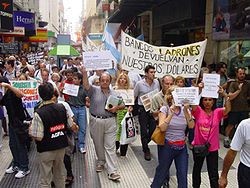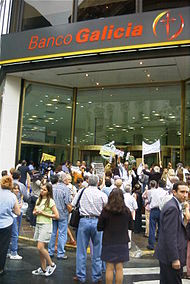- Corralito
-
Argentine economic
crisis (1999–2002)Economy of Argentina
Peso (currency)
Currency Board
Corralito
Cacerolazo
2001 riots
Apagón
Debt restructuringedit Corralito (Spanish pronunciation: [koraˈlito]) was the informal name for the economic measures taken in Argentina at the end of 2001 by Minister of Economy Domingo Cavallo in order to stop a bank run, and which were fully in force for one year. The corralito almost completely froze bank accounts and forbade withdrawals from U.S. dollar-denominated accounts.
The Spanish word corralito is the diminutive form of corral, which means "corral, animal pen, enclosure"; the diminutive is used in the sense of "small enclosure" and also "a child's playpen". This expressive name alludes to the restrictions imposed by the measure.
Contents
Background and initial measures
In 2001, Argentina was in the midst of a crisis: heavily indebted, with an economy in complete stagnation (an almost three-year-long recession), and the exchange rate was fixed at one U. S. dollar per Argentine peso by law, which made exports uncompetitive and effectively deprived the state of having an independent monetary policy. Many Argentines, but most especially companies, fearing an economic crash and possibly a devaluation, were transforming pesos to dollars and withdrawing them from the banks in large amounts, usually transferring them to foreign accounts (capital flight).[1]
On 1 December 2001, in order to stop this draining from destroying the banking system, the government froze all bank accounts, initially for 90 days. Only a small amount of cash was allowed for withdrawal on a weekly basis (initially 250 Argentine pesos, then 300), and only from accounts denominated in pesos. No withdrawals were allowed from accounts denominated in U.S. dollars, unless the owner agreed to convert the funds into pesos.[2] Operations using credit cards, debit cards, cheques and other means of payment could be conducted normally, but the lack of cash availability caused numerous problems for the general public and for businesses.
Immediate effects
 A protest against the banks in 2002. The large sign reads "Thieving banks - give back our dollars". The green and light blue object in the middle of the crowd is a Payphone.
A protest against the banks in 2002. The large sign reads "Thieving banks - give back our dollars". The green and light blue object in the middle of the crowd is a Payphone.
The corralito caused an immediate backfire on the government. Even more people started trying to withdraw their money from the banks, and many ended up in court fighting for their right to have their funds (and being granted that right on occasion).
The main reason for ending up in court was that, after the corralito, and after Economy Minister Cavallo resigned, the new government led by Eduardo Duhalde and his Economy Minister Roberto Lavagna converted those funds nominated in US Dollars, into Argentine Pesos at a 1 Peso = 1 US Dollar exchange rate, while the exchange rate was liberalized (immediately going to 4 Pesos = 1 US Dollar).
The same was done with debtors, so many private enterprises and also the Province of Buenos Aires were favoured by this measure as they managed to decrease their debts. Nine years later, several people have not yet been able to recover their savings because of the pace of Justice in Argentina. However, debtors were able to purchase properties and other items by paying their debts at the 1 to 1 exchange rate.
At the time, the average Argentine did not employ the banking system for daily uses; many did not have a personal bank account, and dealt only with cash. Debit cards were not popular and many businesses did not have the equipment to accept them. Thus the cash restrictions only exacerbated the recession and angered the public. President Fernando de la Rúa was forced to resign on 20 December 2001 after violent riots, but the restrictions of the corralito were not lifted at the time.[3]
Corralón
Argentina's situation worsened for several months. The corralito was hardened during the interim rule of President Eduardo Duhalde, and turned into a corralón ("big corral"). The corralón differed from the corralito in that most deposits were forcibly exchanged for a series of bonds denominated in pesos. The dollar-denominated accounts were automatically exchanged for pesos and peso bonds at a predetermined rate. The real necessity of such decision was questioned by several observers at the time, and some suggested this move benefited some large companies which were insolvent (or nearly so) whose owners had sent their dollars abroad before the corralito; these owners were thus able to repay their companies' now devalued debts by converting much fewer dollars than it would have taken previously[4]
The peso was first devalued (from 1.0 to 1.4 pesos/dollar)[5] and then floated, thereby quickly depreciating to a maximum rate of nearly 4 pesos per dollar.[6] Argentina's economy then gradually began a recovery from its abysmal state, spurred by exports that benefited from the heightened exchange rate, and by the declaration of default on most of its debt, which left the government with more money available to expand the economy.[7]
The banks and their role in the crisis
It is generally agreed that the banks had a share of the blame for the situation that led to the corralito.[8] In mid-2001, it was probably clear to bank owners and high-ranking officials that Argentina's banking system was going to crash, and some in fact may have spurred this outcome by letting their highest deposit holders know this news. These, mostly large companies, quickly moved their deposits abroad. Meanwhile, they continued to recommend their middle-class customers to enter deposits.
It is also believed that in the end the corralito ended up being good business for some international banks since they negotiated with the Argentine government to receive compensation bonds for the "missing" money, which in a large proportion had never really left their banks, only moved from one branch to another.[9]
Most banks stayed in the country during the crisis, withstanding a severe damage to their reputation as well as (in certain cases) physical attacks. Others fled as soon as problems arose (for example, Scotiabank's Argentine branch, Scotiabank Quilmes).
The end of the corralito
The corralito officially ended on 2 December 2002, when Minister of Economy Roberto Lavagna announced the liberation of deposits for about 23.7 billion pesos (though not of 17.3 billion pesos in formerly dollar-denominated long-term accounts).[10] The measure was coupled with exchange market controls, by which no person or business was allowed to buy more than 100,000 dollars; this was done to prevent the possible effects of the sudden availability of pesos.
References
- ^ "The Man Who Came In from the Crash" - Harvard Independent.
- ^ "The crisis in Argentina" - socialistworld.net
- ^ "Oxford Analytica Brief: Argentina's Economic and Political Situation" -United Jewish Communities
- ^ Krishock, Dan. "74 and counting". Buenos Aires Herald. http://www.buenosairesherald.com/columnist/note.jsp?idContent=7921. Retrieved 2006-07-06.[dead link]
- ^ "Cautious reaction to peso devaluation" - BBC News.
- ^ "El peso argentino toca fondo" - BBC Mundo. (Spanish)
- ^ "Becoming a serious country" - Economist.
- ^ "The Argentine Crisis: A Chronology of Events After The Sovereign Default" - Standard & Poor's
- ^ "Argentina: Program for a Popular Economic Recovery" - Monthly Review.
- ^ "Argentina: llegó el fin del 'corralito'" - BBC Mundo. (Spanish)
-
- El Correo
- "Argentina's crisis revisited" BBC News
See also
- Cacerolazo
- Fractional-reserve banking
- Third World debt
Categories:- Economy of Argentina
- Presidency of Fernando de la Rúa
Wikimedia Foundation. 2010.

